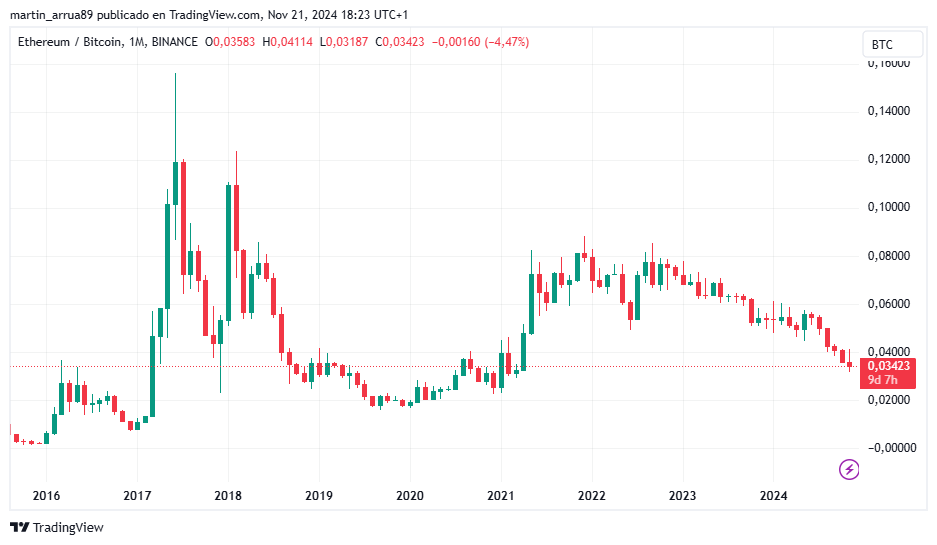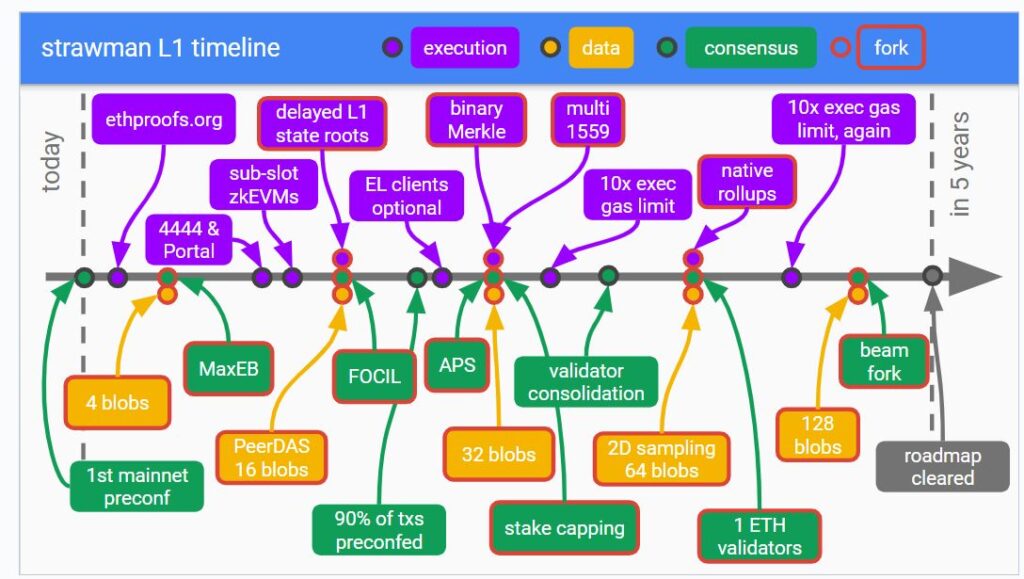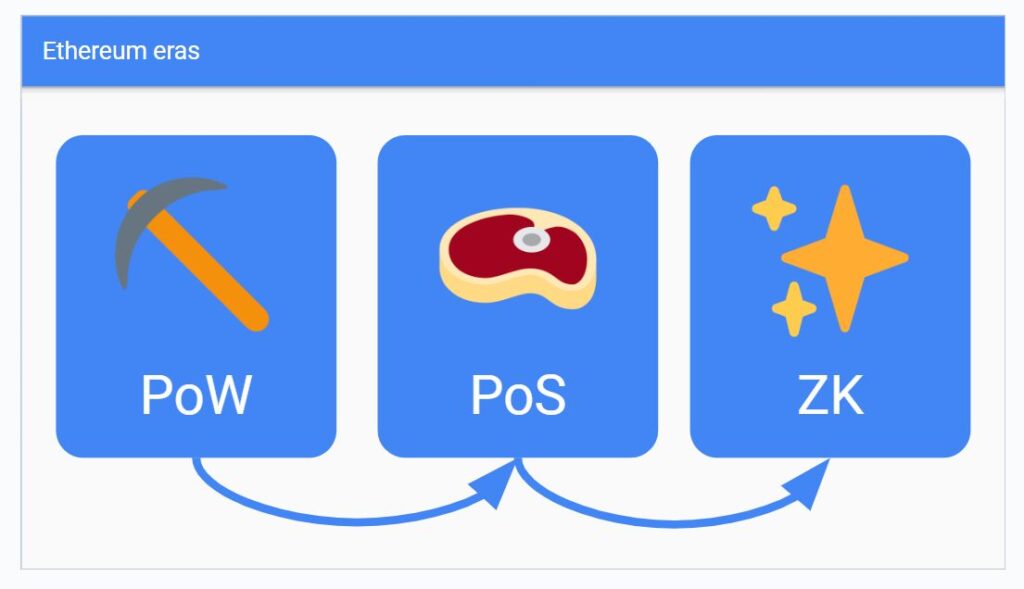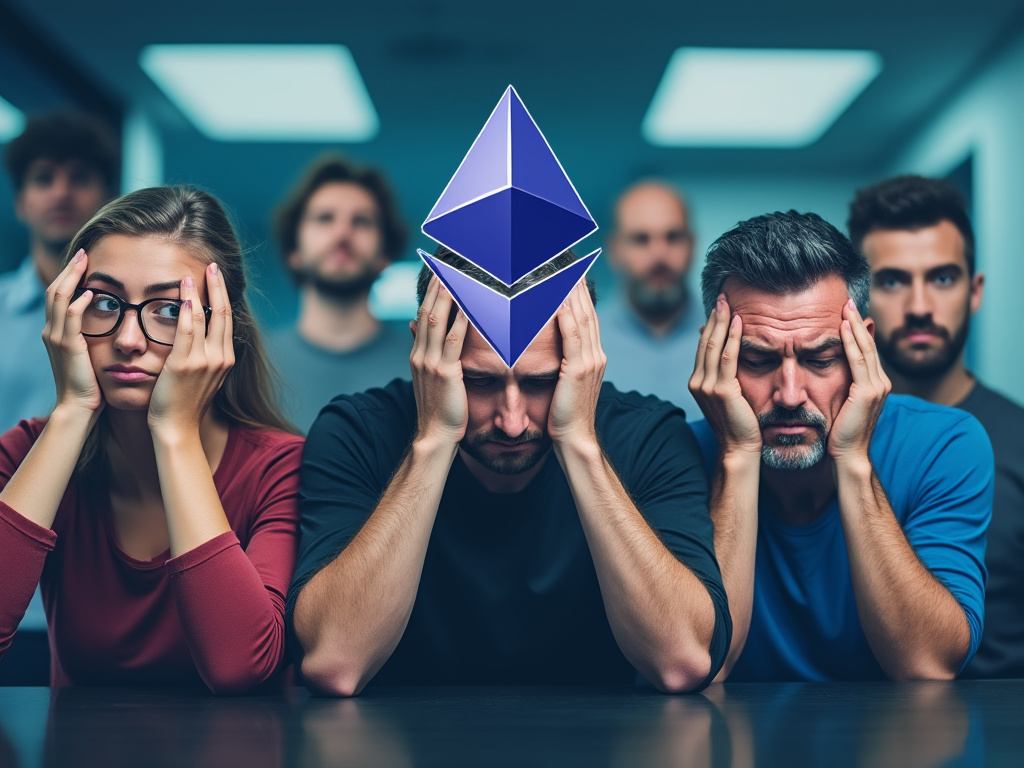For the specialist, “Ethereum does not compete with Solana but with Bitcoin.”
Unlike 2021, narratives do not accompany Ethereum.
Paul Ironforce, pseudonym of an Argentine specialized in decentralized finance (DeFi), spoke about the low price of ether (ETH), the native cryptocurrency of the Ethereum network.
If its price is measured in BTC, ETH currently has the lowest price since 2021, as can be seen in the following chart. TradingView:

Through his X account, Paul Ironforce raised: “Why isn’t ETH going up? My short answer is: because that’s the market, beyond the narratives. There are stages and now BTC is with very high dominance.”
In any case, Ironforce also targeted Ethereum Foundation for its financial strategy:
«The FUD came in networks. On top of that, terrible management by the Ethereum Foundation, which has less tact than a man, selling ETH to pay current bills. I wonder why instead of selling they don’t put up collateral and take out loans while the price goes up… right? It would be a good sign for the holders and to demonstrate that DeFi works.
Paul Ironforce, DeFi specialist.
As CriptoNoticias has reported, the Ethereum Foundation made headlines repeatedly for selling significant amounts of ETH to cover its expenses, something that generally causes mostly negative reactions in its community.
The decision to sell large amounts of ETH opened the debate about the influence of the Foundation and the future of the network, as a decentralized project.
These questions open the door for other networks like Solana to take center stage and position themselves as a technological alternative to Ethereum.
As explained in Criptopedia, educational section of CriptoNoticias, Solana is considered by many a “Ethereum Killer” (Ethereum killer) and offers a faster and cheaper alternative.
However, for the specialist: «Ethereum does not compete with Solana, it competes with Bitcoin. Solana to play against the L2 layer. To do this, it highlights some key concepts of the network for the coming years: infrastructure, scalability, decentralization and security.
To explain why there is no point of comparison, Ironforce begins its analysis by mentioning the implementation of the update known as Merge.
With this activation, Ethereum changed Proof of Work mining (proof of work or PoW) to Proof of Stake (proof of stake or PoS). From that moment, a group of validators is in charge of confirming transactions which are added in each new block in the chain.
“Technically, the Beacon Chain (PoS) with the Ethereum execution layer, maintaining compatibility with existing smart contracts and dApps,” added the Argentine specialist.
In addition, it prepared the ground for developing future improvements such as sharding. It is a technique that divides the blockchain into fragments (shards, in English), with the aim of improving scalability and cost reduction of gas rates. In this way, transactions in that environment are more accessible.
Ironforce’s journey through the roadmap serves to illustrate how developers are working to consolidate these advantages through a series of technical updates that, if all goes as planned, could revolutionize the world of cryptocurrencies.
The Ethereum Roadmap
The network is developing the update The Surgewhich will improve scalability significantly. As Ironforce points out, at this stage the blobs are introduced with Proto-Danksharding (EIP-4844), a step prior to sharding mentioned above.
These are structures that contain large volumes of data and are stored outside the main Ethereum chain. “They are critical to making rollups cheaper (layer 2), reducing the cost per transaction without saturating the base layer. Once fully implemented, Ethereum will be divided into 64 shards that will process data and transactions in parallel, exponentially increasing the capacity of the network,” explains the DeFi specialist.
Below is the roadmap with improvement proposals for the coming years, where you can see the changes in execution (purple squares), data (yellow), consensus (green) and forks (red).

It is also currently being developed The Verge, an improvement that will reduce the data load on the network through the implementation of “Verkle Trees”. In this regard, Ironforce says that this term refers “to advanced data structures that allow nodes to store less information while verifying the entire chain, improving speed and reducing operating costs for validators.” He further details:
“This dramatically reduces storage requirements and makes it easier to operate lightweight nodes. Operating a full node will be more accessible, increasing decentralization by allowing any common device to participate in the network.”
Paul Ironforce, DeFi specialist.
In that same post, Ironforce says it is still pending The Purgean update that will clean up and reduce historical data on the Ethereum blockchain that is no longer useful. “State optimization will improve synchronization times and reduce the load for new nodes. The goal? Reduce operating costs, increase participation and guarantee long-term technical sustainability,” he completes.
Finally, it appears The Splurgewhich serves to perfect previous updates. In other words, it is the process of polishing the network and ensuring that new improvements are integrated effectively.
Once the changes are implemented, the network prepares for its next milestone: Ethereum 3.0.
What is Ethereum 3.0?
Continuing with his analysis, Paul Ironforce mentions the use of zero-knowledge proof technologies (Zero-Knowledge Proofsin English, and its acronym is ZK) that seeks to accelerate this roadmap.
This is where the term Ethereum 3.0 is used, to refer to the evolution of the environment created by Vitalik Buterin, even though it does not appear in the official project. The concept refers to technological incorporations to expand the capacity of the network.
According to the specialist, “it is a proposal to introduce the Beam Chain that would be executed with ZK”, and expands: “This issue arises from a proposal to accelerate the roadmap using ZK-SNARKs and ZK-STARKs”.
Now, here it is important to stop for a moment to understand what these terms mean. In principle, Beam Chain It is a technology that allows you to identify the validity of data without revealing it, which can make transactions faster and more private.
Meanwhile, ZK-SNARKs and ZK-STARKs are used to verify the veracity of a data without needing to reveal all underlying information. “With ZK, these tests could be used to verify complete blocks without the need for all nodes to process each transaction. This would increase privacy and scalability but, above all, it would accelerate the roadmap between now and 5 years,” says the Argentine.
Although it is not something new, says Ironforce, it has become more relevant since Justin Drake, one of the Ethereum developers, presented the roadmap in detail.

It also highlights that, despite the controversies generated by the estimated time (5 years) for the full implementation of these improvements, there will be intermediate updates and substantial improvements in the sub-layers: execution (gas reduction per second), data (number of bytes per sec) and consensus.
Regarding the latter, Ironforce highlights a novelty that will generate more participation in the Ethereum ecosystem. “In addition to reaching up to 90% of pre-confirmed transactions by roll-ups We could go to a scenario of validating the network with only 1 ETH thanks to the fact that there could be a validator that groups them together. Bye at 32 ETH”, he celebrates.
There appears the concept of Chain Snarkfication which “reduces the dependence on hardware which, together with the possibility of validating with 1 ETH, would make it possible for thousands and thousands of new validators to join the network in a much lighter way.”
These issues are key because it implies greater democratization of access to validation, which will increase the decentralization of that environment. In this way, it could consolidate its place as a more inclusive network for the future.
In conclusion, the tour of the roadmap serves to see the solid foundations on which Ethereum is built, which could boost the price of your cryptocurrency despite that discouragement that Ironforce perceives. “The strength of its network is based precisely on its infrastructure, scalability, decentralization and security, key to what is to come,” he completes.






Leave a Reply